© 2022 All rights reserved Worktop Library
Stunning kitchen splashbacks and feature walls with concrete, porcelain and marble.
It is a new year, and new design trends are coming. Today, we will look at recent tendencies in interior design and architecture. Today’s trend is in kitchens and living rooms on a detail we love: adding a wall covered in marble, porcelain, or quartz.
In this article, you will find:
- Mix the old with the latest to create a feature wall with dazzling glamour.
- Make your home sustainable by combining innovative materials, natural stones, and old-fashioned details in the walls.
- Examples of new products that instantly make your kitchen and living rooms look lavish but are budget-friendly.
- Installation Process: Every material brings its complexities and challenges.
- Maintenance Tips: We’ve got expert tips on maintaining each kind of material–keep your design elements looking fresh and new for longer!
- Comparative Analysis: Are you mulling over several options? Our side-by-side comparisons could simplify your decision-making process.
- Environmental Impact: If you’re eco-conscious, we’ll help you make an informed choice that aligns with your values.
- Alternative Budget-Friendly Options: Style doesn’t have to break the bank. Discover stunning, cost-effective alternatives.
- Colour Trends: Inspiration awaits in sections diving into the hottest colour trends and combinations for your feature walls.
- Conclusion
We think these will be in many UK homes coming into 2024. With this in mind, we will discuss interior design ideas for architectural stone feature walls.
We have seen many feature walls painted with metro tiles or brickwork in 2021. But today, we will take you in the direction of considering architectural details when designing your kitchen and living room.
Wall decoration trends 2024: Mix the old with the latest
These elements might look like they are part of your home, giving it an old-style feel or a little bit more worn-out. As an example, you can see below a kitchen splashback:
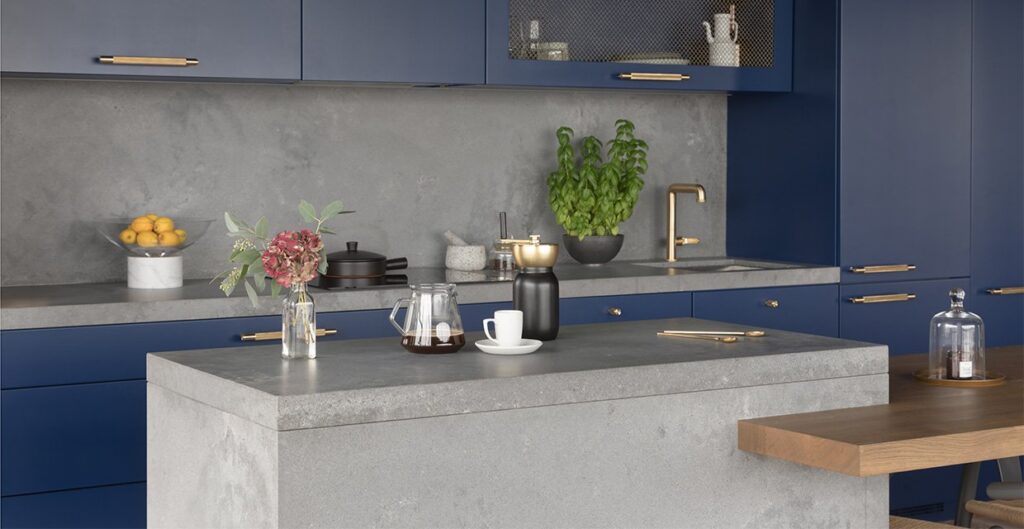
Although the above splashback looks like Concrete, it is, in fact, quartz stone. And it is one of our favourite details in the 2024 kitchen design trends. We love it because it has an old-world European feel, but it is a new and revolutionary surface material that is easy to use and clean.
A perfectly constructed stone feature wall
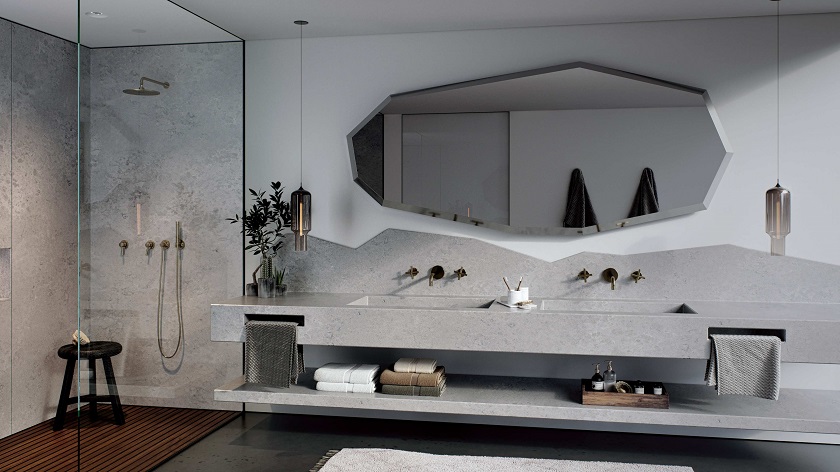
Make your home sustainable by combining innovative materials, natural stones, and old-fashioned details on the walls.
A contrasting stone can add a somewhat old-fashioned look without being antiquated. In addition, you can add hints of colour to break away from a monochromatic design. See the below image example of a two-tier kitchen island:
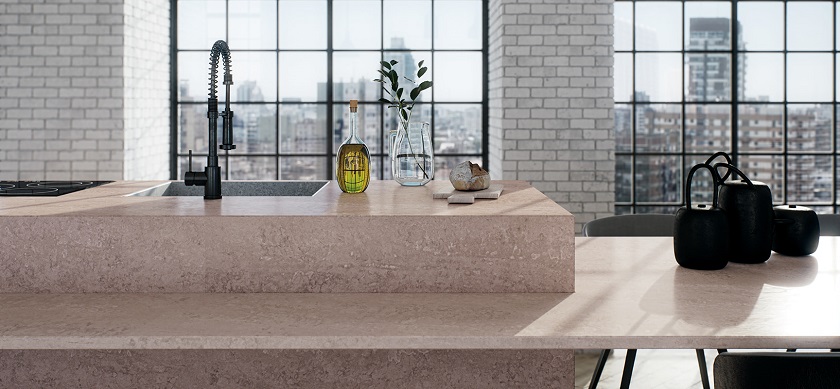
The above photo shows another architectural element that feels like it could be part of your home, as if it was quarried over time, which is fantastic. In the above case, the Concrete effect worktop and brick combination in the kitchen brings a European feel. It instantly makes us think of the buildings you see across the continent.
It combines concrete with exposed brick and other elements from handmade and bespoke eras. Hence, another detail can take your home and make it feel more expensive, handcrafted, and unique. And it is one of our favourite details that work incredibly well in any kitchen setting.
The best thing about creating this look in a kitchen is its spaciousness. However, the entire floor wall looks like stone, and kitchen cabinets and appliances occupy some space. Similarly, a range cooker’s hood takes up a lot of space. Therefore, you don’t need as much stone as you think if it is only a wall. Another excellent place to apply this look is your living room.
Using porcelain and marble in wall features creates a vintage feel in modern homes.
Here is an example of a living room with a minimalistic yet classic living room. In detail, It has a similar old-style feel with a Nordic-inspired look.
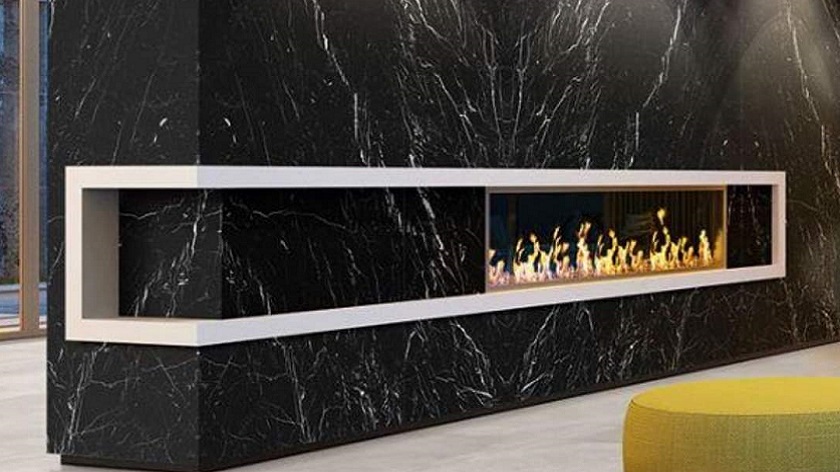
The above living room has a fireplace. Seeing that it helps you not buy as much stone gives you a sensation that there is a lot of marble around it. While a stunning wall, it warms up the space, giving it some interesting white vein detail on a Black Marquina Marble backdrop.
We love how you wouldn’t think that stone would give you a feeling of warmth or cosines. However, if that was only a plain wall, you can see how it could sometimes feel somewhat sterile if you don’t have these touches of architectural details. Therefore, things like adding beams or, in this case, an architectural feel with the stone make the space feel inviting and cosy and custom, handmade type feel.
Your living room can become a beautiful space. In other words, you can see what I’m talking about by taking something that might be plain and just adding a detail that takes it to the next level.
We will continue to see this trend in 2024, playing out with these materials, where it feels like they have been part of the home and the construction aspect for many years. But, in addition, we believe this kind of design wasn’t popular in past years, only because it was expensive.
Examples of new products that instantly make your kitchen and living rooms look lavish but are budget-friendly.
In previous years days, people used the materials that they had around. But with the latest technologies for extracting natural stones, new trends emerge. Similarly, manufacturers of porcelain slabs can now create genuinely construction-inspired imitations at reasonable prices.
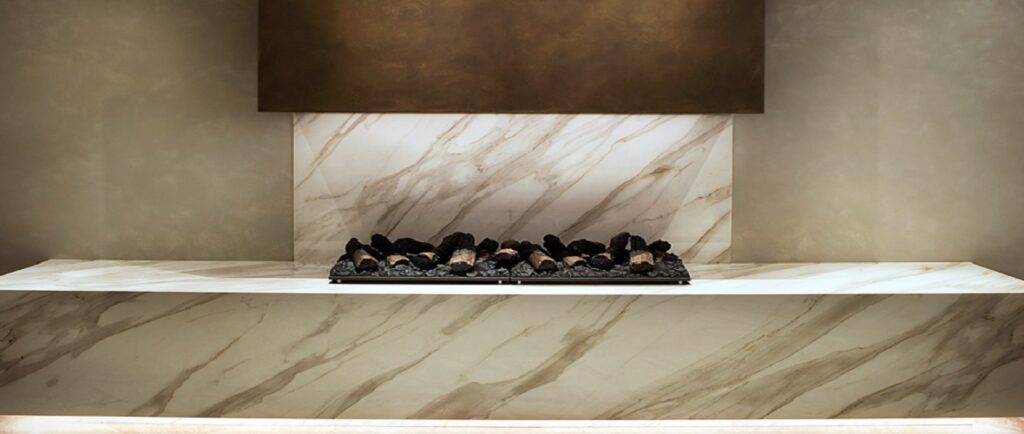
Here is another example of using traditional terrazzo surfaces in a modern setting, giving an architectural detail to the room. The best thing about the new Terrazzo is that you can use them as worktops and apply them to feature walls. However, Terrazzo’s origins may be traced back to Egyptian mosaics, Italy’s most recent forerunners.
A Venetian pavement inspires the modern form of Terrazzo from the 18th century. In this case, artisans placed marble shards next to each other in a mortar foundation. For instance, today, Terrazzo brings about the Art Deco and Moderne styles into modern homes from the 1920s to the 1940s.
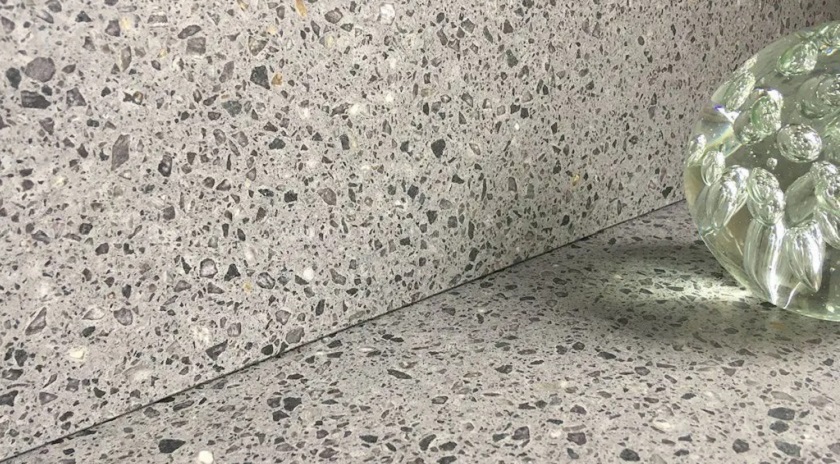
“Design is not just about aesthetics; it involves complex processes, value for money, and environmental impact. Your design choices should reflect your values, preferences, and long-term plans. That’s the goal of our comprehensive guides,” notes acclaimed interior designer Zoe Foster.
In this article, we also aim to consider all aspects of your design journey from every possible angle–all valuable aspects that an existing article might’ve just skimmed over. Covering every detail from the installation process, cost, and durability to maintenance, sustainability, and colour trends. Curious about future trends and budget-friendly alternatives? We’ve got those covered, too.
Understanding the Installation Process
Before getting started, it’s imperative to understand the intricacies of the installation process. Whether you choose concrete, porcelain, or marble, each material has complexities and considerations.
- Concrete: The weight and texture of concrete pose unique challenges during installation. It requires extra reinforcement and a flat, level surface for proper installation.
- Porcelain: While comparatively more uncomplicated to install, Porcelain still needs a certain degree of finesse and skill. Remember to ensure all surfaces are completely flat before installation.
- Marble: Known for its volatility, marble installation is best left to professionals to avoid the risk of cracking or breaking.
- Quartz: It weighs an average of 45% less than granite and is available in ultrathin 12mm slabs for worktops and walls.
Maintenance Tips for Splashbacks and Feature Walls
Once installed, maintenance is vital. Here’s a handy guide to help you care for your choice of material.
- Quartz: No sealing is necessary to prevent staining and wear.
- Porcelain: Available in numerous finishes, the care can vary, but generally, a damp cloth with mild detergent will do the trick for most messes.
- Marble: Marble requires gentle care – avoid acidic or abrasive cleaners that can damage the stone.
- Terrazzo: It requires sealants every 18-24 months.
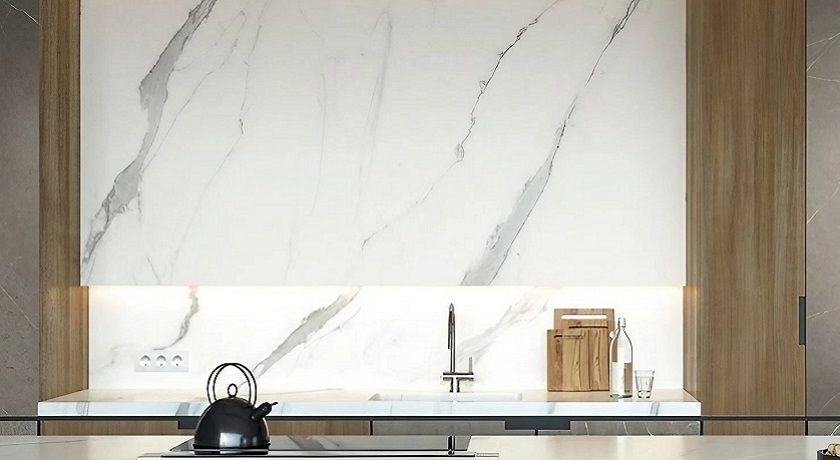
A Comparative Analysis of Materials
To help you make an informed decision, let’s delve into a comparative analysis of each material’s cost, durability, and maintenance needs.
| Material | Cost | Durability | Maintenance |
|---|---|---|---|
| Terrazzo | £ | High | Moderate |
| Quartz | £-££££ | High | Low |
| Porcelain | ££-££££ | High | Low |
| Marble | £-£££££ | High | Medium |
Reflecting on The Environmental Impact
With the increasing emphasis on sustainability, it’s crucial to ponder the environmental impact of these materials. For environmentally-conscious readers, considering the resources needed for extraction, processing, and transportation can influence their material selection.
Leading quartz manufacturers Cosentino (Silestone), Caesarstone and Compac Surfaces are already producing eco-friendly quartz. Cosentino produces Hybri-Q quartz slabs with a minimum of 40% recycled material, conserving sustainability and circular economy. In some cases, such as the Compac Obsidiana range, 100% raw minerals.
Sintered stones from Neolith, Dekton, Marazzi The Top, Porcelanosa, Sapienstone and Ascale Tau, amongst others, produce their stones eco-friendly, avoiding or minimising silica content.
Exploring Budget-friendly Alternatives
If you’re seeking ways to stay on-trend without breaking the bank, exploring budget-friendly alternatives such as high-pressure laminate, manufactured stone, or glass could be the answer. They offer a chic aesthetic appeal while being gentler on your pocketbook.
Soaking in the Colour Trends
Current colour trends lean towards warm neutrals, soft blues, and greens for a calming and contemporary aesthetic. On the other side of the spectrum, wall cladding with exotic Calacatta marble or quartzite continues, making bold veins a modern feature.
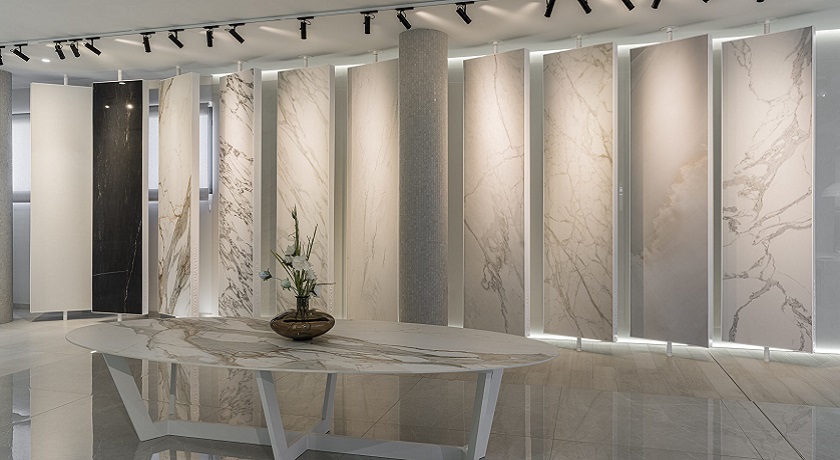
Combining these colours with the textures and shades of your chosen material can create visually stunning feature walls.
Interactive Elements
To further your expertise, be sure to take advantage of interactive elements such as:
- Video tutorials
- 3D modelling
- Design tools and apps
Technological advancements have made access to instructional videos and workshops remarkably handheld. Detailed video tutorials can guide you through your DIY installation process, assisting in understanding the best techniques for dealing with materials like concrete, porcelain, and marble. You can find various YouTube channels and Vimeo pages dedicated to these tutorials. Also, manufacturers often provide install guides on their websites.
Coming to 3D modelling it’s swiftly emerging as a critical tool in the world of interior design. You can utilise it to visualise configurations of your kitchen splashbacks or feature walls and experiment with different materials. Software such as SketchUp or Homestyler allows you to create a virtual 3D model of your house and see how your choices impact your space, providing a safer design exploration environment.
Design tools and applications have been introduced to simplify your planning, designing and installation process. Apps like Houzz and Pinterest provide design inspirations and feature articles with tips for installation and trends in home décor. Besides these, some apps could even recommend contractors in your area if you prefer to employ professionals.
Next, explore real-world examples that have successfully employed these interior design trends.
“We recently completed a project where the homeowner opted for a beautiful marble splashback,” shares renowned interior designer Emma Jeffs. “Supported by our 3D visualisation presentation, they were confident in their choice. The result was stunning – adding an element of luxury to their kitchen, which is now the room’s focal point.”
It is always insightful to consider future design trends, keeping longevity in mind. Innovative materials like nanotech quartz – resistant to scratches, water, and heat – are rising. Not only this, but we are also noticing a leaning towards ‘smart walls’ and induction porcelain worktops equipped with digital interfaces and improved functionality, meeting the requirements of a technologically progressive society.
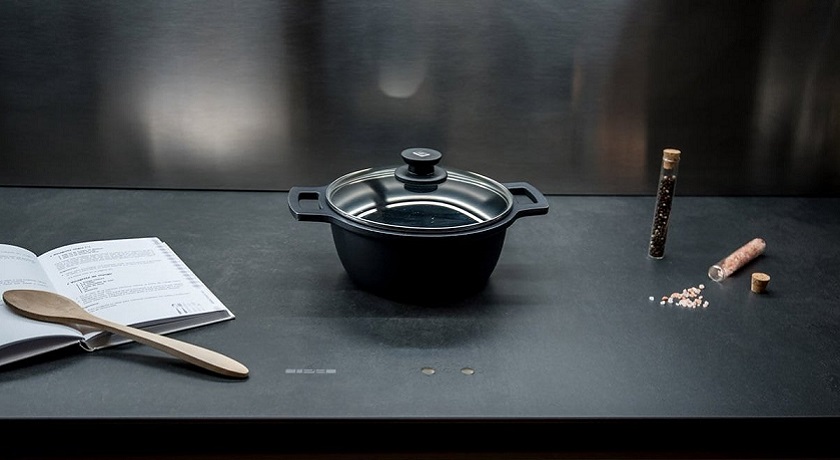
“2025 and beyond will see a move towards adaptive kitchen designs,” predicts architect Sarah Williams. “Think splashbacks with integrated smart technology, enabling you to control appliances or even browse recipes directly on your wall surface.”
With this prediction in mind, excited homeowners can anticipate a future where function and aesthetics merge harmoniously. Imagine checking your emails or browsing the web on your kitchen splashback while waiting for your morning coffee! It’s not so farfetched, particularly considering the rapid pace at which technology evolves.
While Williams’ prediction paints an exciting picture, other experts also speak of a move toward sustainability as a significant trend in interior design’s future. Integrating green practices and eco-friendly materials into a home’s design seems to be more of a norm than a trend, driven by an increasing awareness of the environmental impact of our choices.
“We’re seeing a push towards more sustainable choices that minimise environmental impact,” interior designer Jake Hudson explains. “This includes a shift to using more natural materials, recycled or upcycled materials, and an emphasis on longevity and durability over fast-changing trends.”
This sentiment is echoed by several experts, reinforcing the notion that future houses will boast remarkable designs and be kinder to our planet. Announcing these two elements – innovation and sustainability – may appear challenging. However, as designers and homeowners rise to this challenge, we can expect extraordinary spaces to emerge.
But what about budget-friendly options? Will these have a place in the future trend narrative? The answer is a resounding ‘yes’. Experts predict that innovations to meet this need will follow as demand grows for pocket-friendly solutions. Some even suggest a movement towards DIY installations, as homeowners seek to further save on costs and personalise their spaces.
“We’re seeing a shift towards more DIY in the interior design space,” observes Hudson. “Budget-conscious homeowners are keen to get hands-on, resulting in a trend towards easy-to-install and budget-friendly materials.”
Case Studies of Successful Implementations
Let’s look at a few case studies to illustrate these trends perfectly. These present real-life instances of homeowners who’ve successfully incorporated these design elements into their homes, providing readers with practical insights and visual inspiration.
- Rochester House: This open-plan kitchen in Rochester has integrated innovative technology into its marble splashback. The sleek design masks an inbuilt system that controls the kitchen appliances and provides web access. The marvel of this innovative design lies in its seamless blend of the classic marble look with cutting-edge technology.
- Bristol Residence: Demonstrating sustainability in action, Bristol Residence used recycled concrete to create a feature wall in their living area. The result? A budget-friendly, environmentally conscious, and decidedly chic interior.
While predicting design trends beyond 2024 involves some guesswork, insights from industry professionals and real-world implementations can give us a fascinating glimpse into the future of home decor.
Names and prices of the materials discussed in this article.
We’re sure that some of these products may have caught your attention. So here are the details of the materials we use for this article. Please note that the below prices do not include labour costs:
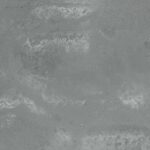
Picture 1 – Caesarstone Rugged Concrete Quartz.
Slab sizes: 3040 x 1440 mm – 3240 x 1640mm
Thicknesses: 20 mm – 30 mm
Finish: Rough Concrete
20mm thick M2 price: £305
30 mm thick M2 price: £362.
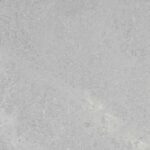
Picture 2 – Caesarstone Airy Concrete quartz.
Slab size: 3240 x 1640 mm
Thicknesses: 20 mm – 30 mm
Finish: Rough Concrete
20mm thick M2 price: £305
0 mm thick M2 price: £362.
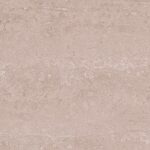
Picture 3 – Caesarstone Topus Concrete quartz.
Slab size: 3040 x 1440 mm
Thicknesses: 20 mm – 30 mm
Finish: Rough Concrete
20mm thick M2 price: £305
30 mm thick M2 price: £362.
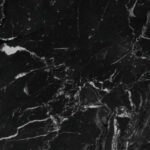
Picture 4 – Nero Marquina Natural Marble.
Average slab size: 3000 x 1800 mm
Thicknesses: 20 mm – 30 mm
Finishes: Polished – Honed
20mm thick M2 price: £115
30 mm thick M2 price: £145.
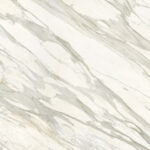
Picture 4 – Neolith Calacatta Gold Sintered Porcelain.
Slab size: 3200 x 1600 mm
Finishes: Silk (matt) – Polished – Ultra Soft
Thicknesses: 3 mm – 6 mm – 12 mm -20 mm – 30 mm
6 mm thick M2 price: from £145
12 mm thick square metre price: from £255
20 mm thick square metre price: from £290.
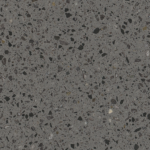
Picture 5 – Technistone Taurus Terrazzo Grey Quartz.
Slab sizes: 3050 x 1440 mm – 3185 x 1550 mm
Finishes: Matt – Polished
Thicknesses: 20 mm – 30 mm
20 mm thick square metre price: £165
30 mm thick square metre price: £199.
Conclusion
If you’re looking to create a design with a similar style, we offer free design consultation to achieve European, organic, or modern style homes. Each of these looks has its style and flair. But whichever type you choose for your home must fit your style and lifestyle. And that’s something you must consider with trends: make sure you don’t do something just because it is trendy. Instead, ensure it resonates with you, which you also want long-term. Ultimately, many of us live in the same homes for an average of two decades.
Therefore, you must ensure you go into every room, building it as if it will be where you will live forever. Choose timeless elements that genuinely suit your style instead of a trend.
If you’re considering redecorating, this article will hopefully inspire you as you plan and design your kitchen, living room, and other spaces. For this reason, hit the subscribe button to avoid missing our future articles!
Author:

Alan Nussbaum
Meet Alan Nussbaum, our Sales and Marketing Manager. With almost two decades of experience, Alan’s impressive track record includes creating one of the first online stone companies in 2012 and pioneering the acceptance of cryptocurrencies in construction in 2018 before co-founding The Worktop Library with Maria.
Alan’s work is featured in numerous Stone and Home Decor magazines. In addition, he collaborates with the industry’s leading stone brands, cementing his reputation as an innovator.
Before starting a thriving career in the stone industry, Alan honed his skills by overseeing luxury fashion brands such as Burberry, Matches Fashion, and Patrick Cox. With his unique blend of experience and expertise, Alan is a true trailblazer in the stone worktop industry. His passion for delivering exceptional service is evident in every aspect of his work.
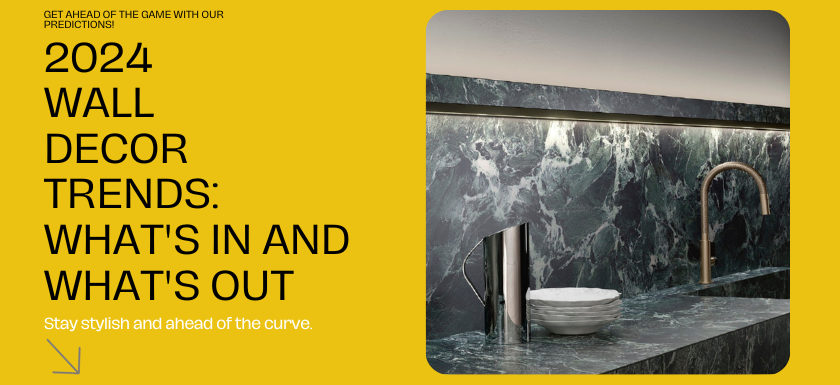
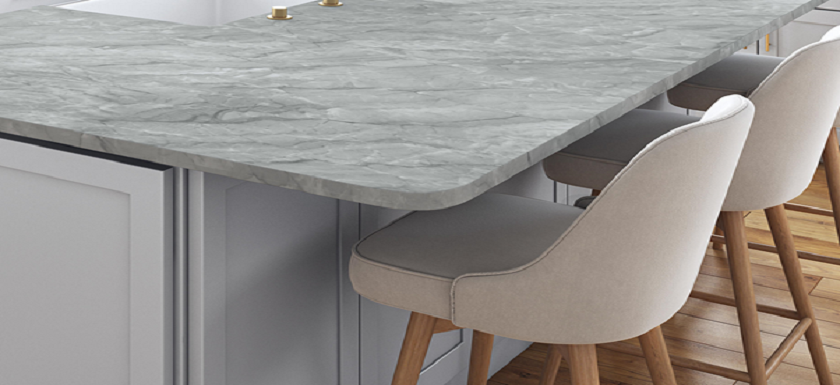 Apr 16 2021
Apr 16 2021 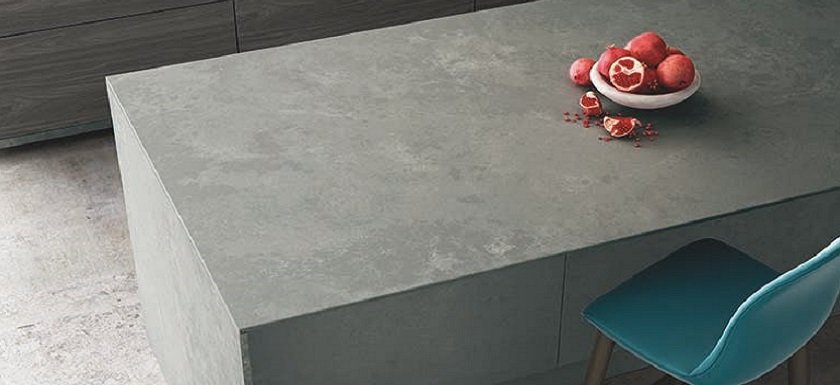 Apr 19 2021
Apr 19 2021  May 05 2021
May 05 2021 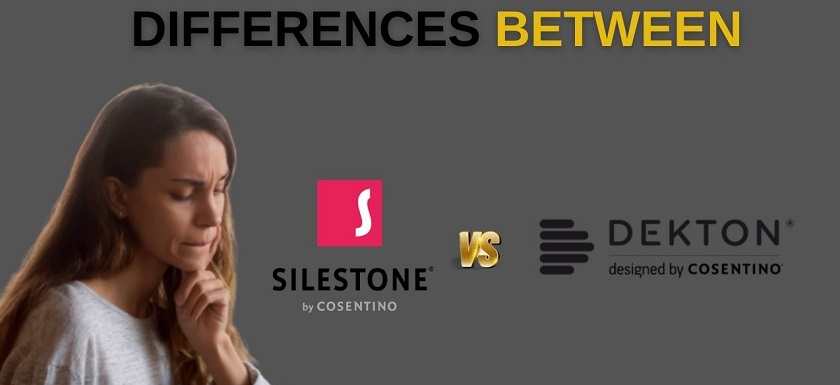 May 07 2021
May 07 2021 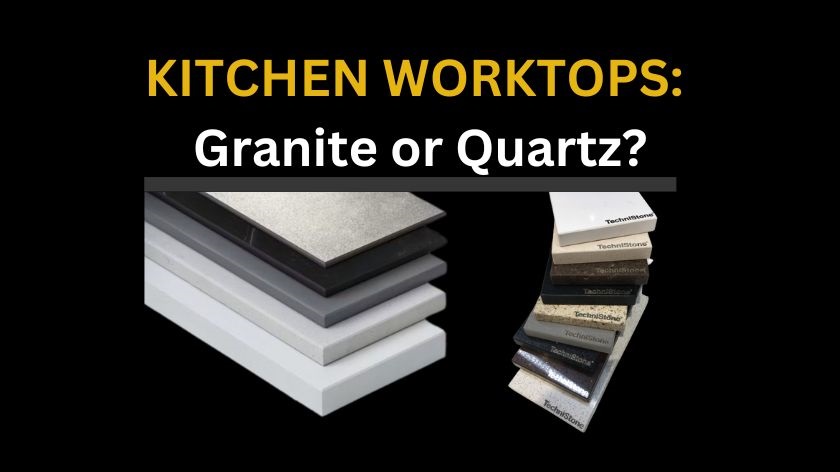 May 15 2021
May 15 2021 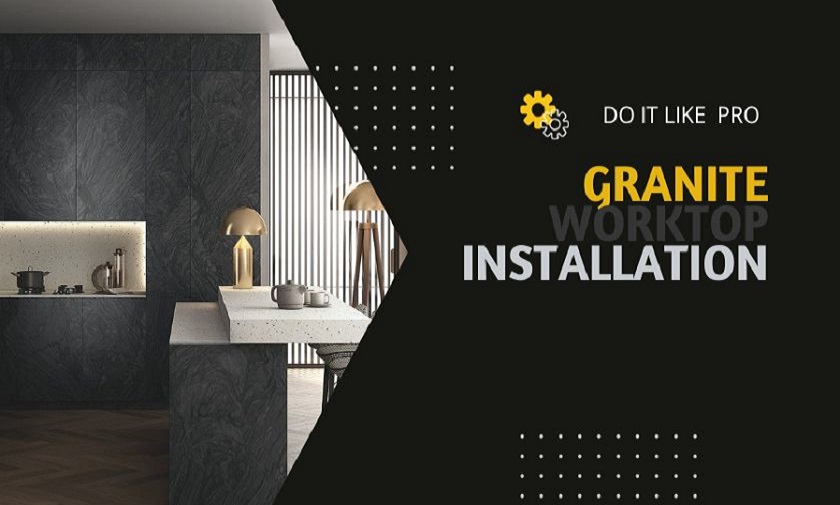 May 17 2021
May 17 2021 